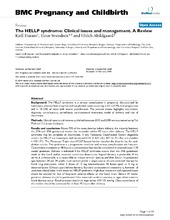| dc.description.abstract | Background: The HELLP syndrome is a serious complication in pregnancy characterized by haemolysis, elevated liver enzymes and low platelet count occurring in 0.5 to 0.9% of all pregnancies and in 10–20% of cases with severe preeclampsia. The present review highlights occurrence, diagnosis, complications, surveillance, corticosteroid treatment, mode of delivery and risk of recurrence. Methods: Clinical reports and reviews published between 2000 and 2008 were screened using Pub Med and Cochrane databases. Results and conclusion: About 70% of the cases develop before delivery, the majority between the 27th and 37th gestational weeks; the remainder within 48 hours after delivery. The HELLP syndrome may be complete or incomplete. In the Tennessee Classification System diagnostic criteria for HELLP are haemolysis with increased LDH (> 600 U/L), AST (≥ 70 U/L), and platelets < 100·109/L. The Mississippi Triple-class HELLP System further classifies the disorder by the nadir platelet counts. The syndrome is a progressive condition and serious complications are frequent. Conservative treatment (≥ 48 hours) is controversial but may be considered in selected cases < 34 weeks' gestation. Delivery is indicated if the HELLP syndrome occurs after the 34th gestational week or the foetal and/or maternal conditions deteriorate. Vaginal delivery is preferable. If the cervix is unfavourable, it is reasonable to induce cervical ripening and then labour. In gestational ages between 24 and 34 weeks most authors prefer a single course of corticosteroid therapy for foetal lung maturation, either 2 doses of 12 mg betamethasone 24 hours apart or 6 mg or dexamethasone 12 hours apart before delivery. Standard corticosteroid treatment is, however, of uncertain clinical value in the maternal HELLP syndrome. High-dose treatment and repeated doses should be avoided for fear of long-term adverse effects on the foetal brain. Before 34 weeks' gestation, delivery should be performed if the maternal condition worsens or signs of intrauterine foetal distress occur. Blood pressure should be kept below 155/105 mmHg. Close surveillance of the mother should be continued for at least 48 hours after delivery. | en_US |

